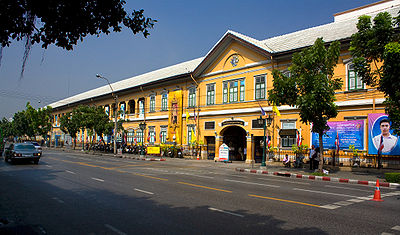Suankularb Wittayalai School
The suankularb wittayalai school ( Thai : โรงเรียน สวน กุหลาบ วิทยาลัย . RTGS : Rongrian Suankulap Witthayalai, pronunciation: [ roːŋrian suănkùlàːp wíttʰájaːlaj ], translates to "Rose Garden Group") is a famous public school for boys of secondary school in Thailand . It is the oldest secondary school in Thailand.
history
The school's history begins at the end of the 19th century in the Grand Palace of Bangkok . Here the royal pages were trained, from whose ranks the royal bodyguard was recruited. The page school was located in an area of the palace called the "Rose Garden" ( Suan Kulap ). In 1871, military training was expanded to include an additional branch in which the pages could learn to read and write as well as the English language. In addition to the pages, the sons of the nobles were also allowed to attend this school, which emphasized a new way of learning. Schoolchildren were not punished here with sticks or insults, as was common practice in similar institutions. In addition, all students were given a uniform and pocket money was paid out. However, the demands of the curriculum on the students were so high that most of them left school early. When the new students later came mainly from middle-class families , a new school was founded on a proposal by Prince Damrong , which was reserved only for boys from the royal family.
On March 8, 1882, King Chulaklongkorn opened the Suankularb School to give intelligent sons of the royal family an educational advantage over the bourgeois class. The first year only boys who had the rank of Mom Chao were educated . But by the second year the number of applicants exceeded those of the page school. Until then, military training was a prerequisite for obtaining a well-paid, leading position in the administration of the Siamese empire, but this was no longer necessary after a decree of the king.
Under the direction of Prince Damrong, who also headed the Ministry of Education, newly established in 1885, until 1892, the Suankularb School remained an elite school for the ruling class. But after only ten years, the origins of the new students were more diverse, many came from families of minor officials or wealthy middle-class people with a Chinese background. Of twenty students in their senior year 1896, only one was of royal descent, four were sons of high-ranking nobles, five of lower-ranking nobles. Eight students were from the middle class and two were of Chinese descent. This contributed to the fact that in 1889 a school fee of 20 baht was introduced annually to "prevent the common people ( คน เลว - khon leo ) from attending school and to cover the cost of lunch".
Towards the end of 1902, in the meantime several new elementary schools were founded in Buddhist temples, the curriculum was adjusted by the Ministry of Education so that the so-called “Standard I” was taught in elementary schools and the so-called “Standard II” in secondary schools has been. As a result, there were now only three other secondary schools in addition to the Suankularb school.
In 1910, so many students attended Suankularb School that the old building on the palace grounds became too small. A new school building was inaugurated on a site that had been donated by Wat Lieb (today: Wat Ratchaburana ). The school is still here today, the building was called the “Long House” because it was the longest house in the country for many years.
meaning
The establishment of the Suankularb School goes hand in hand with the beginning of modern training methods in Thailand. For over a century the alumni of the school have been among the leaders in the fields of politics, social affairs and the military . Many of them work in high government agencies and were and are part of the modernization of Thailand. Together with three other very traditional and prestigious boys' schools, it organizes the Jaturamitr Samakkee football tournament every year .
In 1973 the Suankularb Wittayalai School was awarded the title “Best School in the Country” by the King. King Bhumibol Adulyadej himself or Princess Maha Chakri Sirindhorn were also present at the opening ceremonies for other buildings of the school in 1984 and 1995.
Former students of the Suankularb Wittayalai School
- Members of the royal family
- Prince Paribatra Sukhumbandh
- Prince Wan Waithayakon
- Thai Prime Minister
- Phraya Manopakorn Nititada
- Pridi Phanomyong
- Tawee Boonyaket
- Mom Rajawongse Seni Pramoj
- Mom Rajawongse Kukrit Pramoj
- Tanin Kraivichien
- General Prem Tinsulanonda
- General Surayud Chulanont
- Military
- General Sunthorn Kongsompong - leader of the 1991 coup and de facto leader of the government from 1991 to 1992
- General Mongkol Ampornpisit
- General Prem Tinsulanonda
- General Surayud Chulanont
- General Ruangroj Mahasaranon - Commander of the Thai Armed Forces from 2005 to 2006
literature
- David K. Wyatt: The politics of Reform in Thailand, Education in the Reign of King Chulalongkorn . Yale University Press, New Haven and London 1969, ISBN 0300-01156-3
Individual evidence
- ↑ Kullada Kesboonchoo: The Rise and Decline of Thai Absolutism . Routledge Shorton, New York 2004, ISBN 0-415-29725-7 ; Page 70f
- ↑ Article in the Encyclopædia Britannica on Prince Damrong (in English)
- ↑ Kullada Kesboonchoo: The Rise and Decline of Thai Absolutism . Routledge Shorton, New York 2004, ISBN 0-415-29725-7 ; Page 72ff
- ^ David K. Wyatt: The politics of Reform in Thailand , p. 121
Web links
- Official school website (in Thai)
Coordinates: 13 ° 44 ′ 34.1 ″ N , 100 ° 29 ′ 55.4 ″ E
